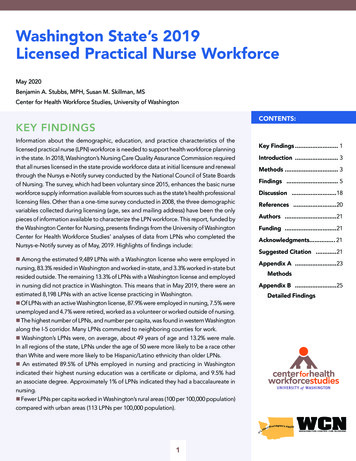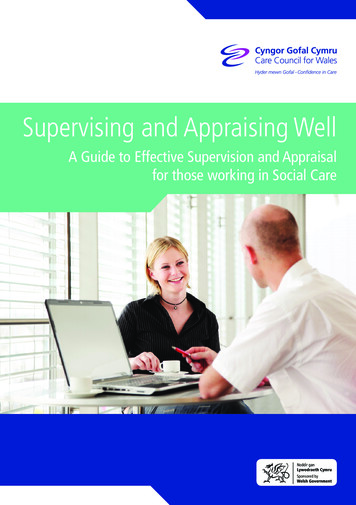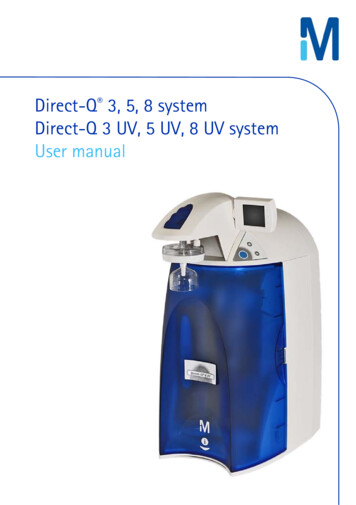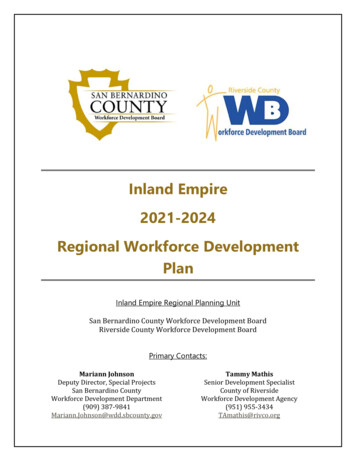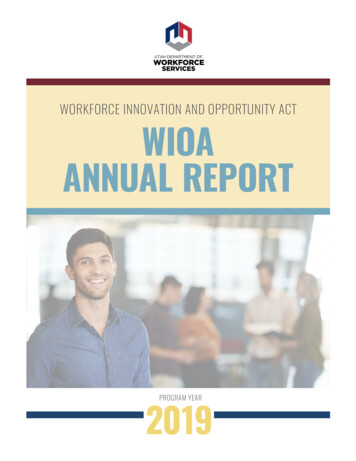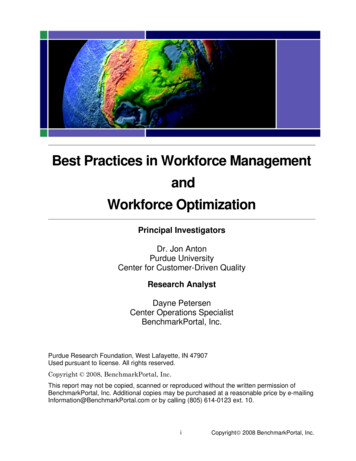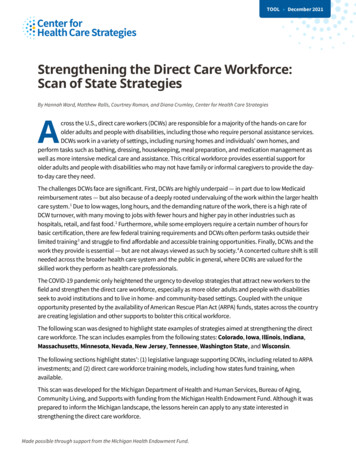
Transcription
TOOL December 2021Strengthening the Direct Care Workforce:Scan of State StrategiesBy Hannah Ward, Matthew Ralls, Courtney Roman, and Diana Crumley, Center for Health Care StrategiesAcross the U.S., direct care workers (DCWs) are responsible for a majority of the hands-on care forolder adults and people with disabilities, including those who require personal assistance services.DCWs work in a variety of settings, including nursing homes and individuals’ own homes, andperform tasks such as bathing, dressing, housekeeping, meal preparation, and medication management aswell as more intensive medical care and assistance. This critical workforce provides essential support forolder adults and people with disabilities who may not have family or informal caregivers to provide the dayto-day care they need.The challenges DCWs face are significant. First, DCWs are highly underpaid — in part due to low Medicaidreimbursement rates — but also because of a deeply rooted undervaluing of the work within the larger healthcare system. 1 Due to low wages, long hours, and the demanding nature of the work, there is a high rate ofDCW turnover, with many moving to jobs with fewer hours and higher pay in other industries such ashospitals, retail, and fast food. 2 Furthermore, while some employers require a certain number of hours forbasic certification, there are few federal training requirements and DCWs often perform tasks outside theirlimited training 3 and struggle to find affordable and accessible training opportunities. Finally, DCWs and thework they provide is essential — but are not always viewed as such by society. 4 A concerted culture shift is stillneeded across the broader health care system and the public in general, where DCWs are valued for theskilled work they perform as health care professionals.The COVID-19 pandemic only heightened the urgency to develop strategies that attract new workers to thefield and strengthen the direct care workforce, especially as more older adults and people with disabilitiesseek to avoid institutions and to live in home- and community-based settings. Coupled with the uniqueopportunity presented by the availability of American Rescue Plan Act (ARPA) funds, states across the countryare creating legislation and other supports to bolster this critical workforce.The following scan was designed to highlight state examples of strategies aimed at strengthening the directcare workforce. The scan includes examples from the following states: Colorado, Iowa, Illinois, Indiana,Massachusetts, Minnesota, Nevada, New Jersey, Tennessee, Washington State, and Wisconsin.The following sections highlight states’: (1) legislative language supporting DCWs, including related to ARPAinvestments; and (2) direct care workforce training models, including how states fund training, whenavailable.This scan was developed for the Michigan Department of Health and Human Services, Bureau of Aging,Community Living, and Supports with funding from the Michigan Health Endowment Fund. Although it wasprepared to inform the Michigan landscape, the lessons herein can apply to any state interested instrengthening the direct care workforce.Made possible through support from the Michigan Health Endowment Fund.
TOOL Strengthening the Direct Care Workforce: Scan of State StrategiesSection 1. Examples of State Legislation Supporting DCWsLEGISLATIVE LANGUAGECONSIDERATIONSCOLORADOIn 2019, Colorado passed SB19-238 (Improve Wages and Accountability Home Care Workers), which requires that the state: [25.5-6-1602] Requests an 8.1% increase in reimbursements from the federal government for services paid for through the home and communitybased waivers. [25.5-6-1603-2] Implements a minimum wage of 12.41/hour for DCWs. [25.5-6-1603-3&4] Sets up distribution and reporting requirements for how funds are spent. [25.5-6-1604] Creates a process for reviewing and enforcing training for personal care services.- Established the Senate Bill 19-238 Training Advisory Committee which produced Senate Bill 19-238: Improve Wages and Accountability for HomeCare Workers report. Appendix 1 (p.18) of the Colorado report has a detailed minimum training curriculum draft. Appropriates an initial 5.68 million of FY 2019-20 budget to accomplish these objectives.Delegating the creation of astandardized training curriculumto a committee that representsdiverse interests can help garnerpolitical and DCW buy in.Colorado’s Proposed ARPA Funding for Home and Community Based Services (HCBS): Retention and hiring bonusesExpand data infrastructure to better understand the current supply and demand for DCWsDevelop a standardized curriculum and training program, increasing specialized qualifications tied to wage increasesEstablish training fundAddress benefits cliff (childcare, housing, education)IOWAIn February 2021, HF 692 was introduced in Iowa, which is a bill for an act relating to the direct care workforce, including the expansion of the direct careworkforce registry. The bill requires the Department of Inspections and Appeals (DIA) to expand the existing federally required direct care workforceregistry to include all certified nurse assistants (CNAs), regardless of employment setting. DIA shall require all employers of CNAs, regardless of employment setting, to report the qualifying employment of a CNA for inclusion in the direct careworkforce registry. Currently, only long-term care facilities are required to report qualifying employment to the registry. The bill requires DIA to convene a stakeholder advisory work group to develop a plan for the expansion of the direct care workforce registry. The billspecifies the components to be included in the plan and requires DIA to submit the plan to the governor and the general assembly no later thanDecember 2021. The bill also requires the Department of Education, Department of Public Health, in collaboration with the Department of Workforce Development,Department of Human Services, and DIA to incorporate the enhanced direct care workforce registry created in the bill into existing health, direct care,and long-term services and supports workforce dashboard data, and to utilize such data in informing the state’s strategies to build a strong health,direct care, and long-term services and supports workforce. In developing online platforms for DCWs, employers, and care recipients, consider coordinating with state agencies to ensure that any workforceemployment data that would enhance the platform is accurately entered.CHCS.orgIn developing online platforms forDCWs, employers, and carerecipients, consider coordinatingwith state agencies to ensure thatany workforce employment datathat would enhance the platformis accurately entered.2
TOOL Strengthening the Direct Care Workforce: Scan of State StrategiesLEGISLATIVE LANGUAGECONSIDERATIONSIOWA (continued)Iowa’s Proposed ARPA Funding for HCBS: Workforce support ― expand direct care registry Increased training and support- Develop unified training platform- Building provider capacity through pilot programs- Training Scholarship Grant ProgramINDIANAAs part of the Indiana 2021 Budget Bill, the Division of Disability and Rehabilitative Services is implementing 14% rate increases to the wages of DirectSupport Professionals (DSP) effective July 1, 2021 upon approval by CMS. This legislation aims to increase the statewide average DSP wage to 15/hr.Implementation requirements outline what is necessary to receive the additional rate.To minimize the impact this rate increase has on individuals and families, the annual cap on the Family Support Waiver budget will increase from 17,300to 19,614.Indiana’s Proposed ARPA Funding for HCBS: Workforce Stabilization Grant Program: Distribute grants to support frontline staff who worked during COVID-19 Expand HCBS provider workforce by creating a strategy, common curriculum for DCWs, career ladders, financial support for workers, statewiderecruitment campaign, a rate for Private Duty Nurses that doesn’t incorporate a daily overhead feeThis legislative change was madepossible in Indiana by partneringwith the Arc of Indiana andIndiana Association ofRehabilitation Facilities.Partnering with communityorganizations can increase buy inwhen developing legislation.MINNESOTAIn 2020, Minnesota Statute 256B.85 outlined the establishment of a participant-controlled Community First Services and Supports (CFSS) program toreplace the existing Personal Care Assistant (PCA) model. The CFSS model aims to expand choice for program participants. Key differences between theCFSS program and the existing PCA program are: In CFSS, a person’s spouse, parent, or minor can serve as a person’s support worker. Individuals who are receiving CFSS services can also be a provider; In CFSS, participants may choose to purchase goods in aid of independence; and A new consultation service provider role will provide education and support in writing for the individual’s care plan.Technology issues whileattempting to transition all PCAsto the CFSS model created adelay. Building technical capacityinto the change plan can helpprograms stay on schedule.The transition was expected to begin in 2021, but has been delayed because the state is still awaiting federal approval.The 2022-2023 Biennial Budget allocates additional funding for this program, which includes increases to the wage floor from 13.25/hour to 14.40/hourin 2021 (or upon federal approval) and to 15.25/hour in 2022, increase to paid time off and holidays, and funding for training stipends.Minnesota’s Olmstead Implementation Office produces workplans to tackle issues in the direct care and support workforce. The Olmstead SubcabinetCross-Agency Direct Care and Support Workforce Shortage Working Group produced a report, Recommendations to Expand, Diversify, and ImproveMinnesota’s Direct Care and Support Workforce in 2018. This report lays out a strategic vision for tackling the crisis in the direct care and supportworkforce. Within this plan, strategies are evaluated on priority, if they require legislative action, if they need state agency action, and if communitystakeholders required for the activity to occur. In the appendix is a wage analysis for Minnesota direct care staff.CHCS.org3
TOOL Strengthening the Direct Care Workforce: Scan of State StrategiesLEGISLATIVE LANGUAGECONSIDERATIONSMINNESOTA (continued)Minnesota's Proposed ARPA Funding for HCBS: Rate increases: 9.7% for services determined by Minnesota’s Waiver Rates system, 10.10% increase for PCAs, CFSS, 5% for home healthStudy on PCA/CFSS wages and use of public programsTraining stipends for members of Service Employees International UnionEstablish an HCBS Workforce Grant ― uses could include stipends, sign-on bonuses, scholarships, achievement awards, etc.NEVADANevada’s SB 93 authorizes recipients of Medicaid to receive reimbursements for personal care services. This in essence establishes a self-directed model(a diversion from the agency-only based structure). This law allows clients with money to pay caregivers more in addition to the standard budget. The associated fiscal note estimates the costs of using a contracted fiscal intermediary to assist beneficiaries with managing the budget of their selfdirected PCS. Their estimate uses rates from Arizona’s Medicaid services.Nevada’s Proposed ARPA Funding for HCBS: Align permanent reimbursement rates to match minimum wage Supplemental payments for home care workers to increase their rates for term of increased matching Conduct rate study similar to the one they conducted in 2002 to determine rate increase needsSB 93 had less of a financialimpact than competing proposalsthat would increase DCW wages.Increasing consumer flexibility byestablishing a self-directed modelcan be an option for increasingpay for DCWs. However, doing somay present equity and accessconcerns for Medicaid recipientswho are unable to self-direct theirpersonal care services, or who donot have the financial ability toaugment DCW income.NEW JERSEYNew Jersey passed SB 3847 in June 2021, requiring the Division of Medical Assistance and Health Services in the Department of Human Services toestablish a program under which a family member of an enrollee in Medicaid or NJ FamilyCare, or a third-party individual approved by the parent orguardian of an enrollee in Medicaid or NJ FamilyCare, may be certified as a certified nursing assistant (CNA) and, under the direction of a registered nurse,provide CNA services to the enrollee through a private duty nursing agency under the reimbursement rates established pursuant to subsection D of thissection, provided that the enrollee is under 21 years of age and qualifies for private duty nursing services under Medicaid or NJ FamilyCare. The divisionshall develop an assessment tool that will allow the division to readily identify enrollees who meet these eligibility criteria. The program will require the family member or approved third-party individual to complete all training, testing, and other qualification criteria asrequired under state and federal law for certification as a CNA. The private duty nursing services agency that will employ the family member orapproved third-party individual to provide private duty nursing services to the enrollee will pay all costs for the family member or approved third-partyindividual to become certified as a CNA. In no case will a family member or approved third-party individual who becomes a CNA be required to repay orreimburse the private duty nursing services agency for the costs of the family member or approved third-party individual becoming certified as a CNAunder the program.CHCS.orgWhen considering how toorganize agency efforts tostrengthen the direct careworkforce, New Jersey’s SpecialTaskforce on Direct CareWorkforce Retention andRecruitment is a strong model.Including DCWs on a specialtaskforce, as New Jersey has,should be considered a bestpractice.4
TOOL Strengthening the Direct Care Workforce: Scan of State StrategiesLEGISLATIVE LANGUAGECONSIDERATIONSNEW JERSEY (continued) The tasks delegated by a registered nurse to a family member who becomes certified CNA will be consistent with the tasks that may be generallydelegated to CNAs pursuant to the rules of the New Jersey Board of Nursing. CNA services provided by a family member of a Medicaid or NJ FamilyCare enrollee or an approved third-party individual who becomes certified asCNA under this program should be reimbursed at a rate of no less than 30 per hour. The Department of Human Services will be required to apply for state plan amendments and waivers as are necessary to implement the provisions ofthe bill and to secure federal financial participation for state Medicaid expenditures under the federal Medicaid program.New Jersey passed SB 2712 in October 2020, establishing a Special Task Force on Direct Care Workforce Retention and Recruitment at the Department ofLabor and Workforce Development. The purpose of the task force is to: Evaluate current direct care staffing levels in the state; Examine policies and procedures used to track data on direct care staffing, including workforce turnover rates in long-term care, staffing statistics, andvacancy rates; Examine the effectiveness of staff retention and recruitment strategies and initiatives that are in place for direct care staff; Identify any existing circumstances that allow for a shortage or surplus of direct care staff; Develop recommendations for legislation, policies, and short-term and long-term strategies for the retention and recruitment of direct care staff toensure an adequate workforce is in place to provide high-quality, cost-effective health care; and Develop recommendations for a waiver process.The task force includes 16 members, as follows: The Commissioner of Labor and Workforce Development, the Commissioner of Human Services, the Commissioner of Health, the Secretary of HigherEducation, and the New Jersey Long-Term Care Ombudsman, or their designees, who shall serve ex officio; Two members of the Senate appointed by the President of the Senate, which members shall not be from the same political party; Two members of the General Assembly appointed by the Assembly Speaker, which members shall not be from the same political party; and Seven public members, including:- One direct care staff professional who has experience as a certified nurse aide in a not-for-profit nursing facility;- One direct care staff professional who has experience as a certified nurse aide in a for-profit nursing facility;- One representative of the Health Care Association of New Jersey, to be appointed by the Governor;- One representative from a statewide majority labor representative in non-profit or for-profit nursing facilities;- One representative of the New Jersey Hospital Association, to be appointed by the President of the Senate;- One representative of the American Association of Retired Persons; and- One representative of LeadingAge New Jersey and Delaware, to be appointed by the Speaker of the General Assembly.New Jersey’s Proposed ARPA Funding for HCBS: Rate increases for Personal Care Assistant, Personal Preference Program, Assisted Living Facility, Applied Behavioral Analysis, Jersey Assistance forCommunity Caregiving, and Support Coordinator programs Home Health Workforce Development ― training, recruitment/retention bonuses, bonuses for agency quality measures (based on satisfaction surveys)CHCS.org5
TOOL Strengthening the Direct Care Workforce: Scan of State StrategiesLEGISLATIVE LANGUAGECONSIDERATIONSWASHINGTON STATEIn the 2021-2023 enacted state operating budget, which passed the state legislature in April 2021: “ 450,000 of the general fund—state appropriation forfiscal year 2022 is provided solely for the nursing care quality assurance commission, in collaboration with the workforce training and educationcoordinating board and the department of labor and industries, to plan a home care aide to nursing assistant certified to licensed practical nurse (HCANAC-LPN) apprenticeship pathway. The plan must provide the necessary groundwork for the launch of at least three licensed practical nurseapprenticeship programs in the next phase of work. The plan for the apprenticeship programs must include programs in at least three geographicallydisparate areas of the state experiencing high levels of long-term care workforce shortages for corresponding health professions and incorporate theparticipation of local workforce development councils for implementation.”Washington’s Proposed ARPA Funding for HCBS:When creating a careeradvancement pathway for DCWs,states could consider designatingresources from general funds tostrategically incentivize a morerobust home care workforce ingeographic regions whereshortages are projected. Improving rates for providers, including raising wages and increasing benefits for individual providers and home care agencies improves HCBS servicesby assuring provider stability Special courses for provider skills trainingWISCONSINExecutive Order #11 – Established the Governor’s Task Force on Care Giving. The final report, Wisconsin Caregivers in Crisis: Investing in our Future,outlined 16 policy proposals. Under each proposal is analysis that includes potential funding sources, as well as estimated costs for each initiative. #9 Direct Care Worker Fund (p. 34) ― transitions the fund from quarterly to an annual review and payout process. #12 State-Wide Direct Support Professional Training (p. 37) ― recommends the creation of a tiered system for career advancement, culminating in aCNA certification for PCAs. #16 – Registry Pilot (p. 18) ― recommends a one-year pilot using the Lightest Touch software platform to establish a home care provider registry.State Biennial Health Services Budget 2019-21 (p. 273) ― budget appropriations increase hourly rates for personal care workers by 1.5% annually from 16.73 to 17.24 an hour across the two-year budget.Wisconsin’s success in increasingtheir direct care workforceappropriations was largely abipartisan compromise.Bipartisan support of DCWinitiatives is a goal to strive forwhen working to strengthen thedirect care workforce.Wisconsin’s Proposed ARPA Funding for HCBS: Increase rates for all HCBS services by 5% Develop professional career ladder with tiered reimbursement by first conducting a survey to get an environmental analysis and establishing a registryfor DCWs to be able to tier payment structure Implement statewide training modules and offer training grants so that providers are incentivized to participate in additional competency training.CHCS.org6
TOOL Strengthening the Direct Care Workforce: Scan of State StrategiesSection 2. Examples of State DCW Training ModelsTRAINING MODEL(S) OVERVIEWFUNDING MODELSTATE CONSIDERATIONSILLINOISDirect Support Persons (DSP) must complete 120 hours of training which cannot be presentedin less than 21 calendar days from when it is initiated. Four online programs can satisfy the classroom components of the DSP training:- College of Direct Support offered by DirectCourse- Relias Learning- Southern Illinois University -Carbondale’s training through their Office of Workforce- Infinitec, which has accounts are tied through employer membership in the InfinitecSocial Services CoalitionTraining costs are reimbursable for any participantthat completes the requirements according topolicy. Reimbursement rates and processes foronline training are the same as those for instructorled courses.In this model, trainees can access thesame training across differentplatforms. Therefore, allowing multiplevendors to satisfy learning criterion canhelp agencies build partnerships.Additionally, setting prices or cappingreimbursement can help prevent largeprice differentials.MASSACHUSETTSLike Michigan, Massachusetts participated in the Personal and Home Care Aide State Trainingdemonstration. Massachusetts deployed a train-the-trainer model to standardize trainingmethodology. The state created an online ten module, 37-hour training format to certifyhome care aides. The training curriculum provides trainees with the entry-level position of“homemaker,” which then can be built upon to translate to home health aide throughadditional training.The Executive Office of Health and Human Servicesadministers and funds the MassHealth PCAprogram through contracts with 18 personal caremanagement agencies and, starting on January 1,2022, one Fiscal Intermediary provisioned throughthe annual state budgeting process.Personal care aides (PCA) are required to go through a three-hour PCA New Hire Orientationwithin six months of their hire date. This training can be done online or through a consumerdirected curriculum. It is free.The Massachusetts Personal Care AttendantQuality Home Care Workforce Council managesvendor service contracts with the CommonwealthMedicine at the University of MassachusettsMedical School and MA 1199 SEIU Training &Upgrading Fund, which manage PCA New HireOrientation.Continuing education is also funded through union membership. Additional information onthe state labor bargaining agreements that were reached in 2020 can be found in theMassachusetts Personal Care Attendant Quality Home Care Workforce Council Annual Report.A train-the-trainer approach allows for amore sustainable education model. Italso ensures training costs arereimbursed for both the trainer and thetrainee.MINNESOTACommunity First Services and Supports (formally PCA) training is free of charge through anonline platform that has a built-in competency assessment.The state partners with the University of Minnesota and Elsevier to offer continuing educationtraining for the direct care workforce through DirectCourse. Many of the courses are offered atno charge. Some trainees qualify for an annual 500 stipend.CHCS.orgUniversity of Minnesota budget was used to createthe original curriculum. To date, the state’scontract with DirectCourse is included in thestate’s annual budget.Partnering with state educationalinstitutions can provide an opportunityto build strong hubs for DCWrecruitment and training.7
TOOL Strengthening the Direct Care Workforce: Scan of State StrategiesTRAINING MODEL(S) OVERVIEWFUNDING MODELSTATE CONSIDERATIONSTENNESSEEThe Direct Support Professionals (DSP) Apprenticeship Program is a work-based learningmodel where individuals are compensated for on-the-job training. Wages increase by 3.50 ormore per hour upon completion of this one-year program. Individuals wishing to enter theDSP workforce or those already associated with an employer are eligible to participate. Thecurriculum for this program is managed by the QuILTSS Institute. This body also manages thecredentialing registry and acts as a liaison for community colleges and four-year institutionswishing to train students in direct care work.This public-private partnership includes QuILTSSInstitute, Tennessee state government, andUnitedHealthcare Community Plan (Medicaidmanaged care organization).In this model, trainees may earn up to 18college credits and a post-secondarylong-term care certificate. Offeringopportunities to earn additional creditsand/or certificates on top of standardtraining requirements may furtherentice individuals to enter the field.WASHINGTON STATEWashington State Department of Social and Health Services (DSHS) operates WashingtonCare Careers, which designates two different kinds of paid caregivers in Washington State:home care aides and certified nursing assistants. A minimum of 75 hours of training arerequired to become a home care aide (70 hours home care aide training; 5 hours oforientation), pass a certification exam, and receive a license. Home care aides only taking careof family members (called “individual providers”) do not have to complete 75 hours oftraining; their mandatory training hours depend on the relationship between the client andthe individual provider. Training costs between 300- 500 for home care aides, and the costof the training is covered under the Collective Bargaining Agreement with the state. The stateworked with stakeholders to develop the training criteria.Washington Care Careers is funded by the Agingand Long-Term Support Administration, a divisionof the Washington State Department of Social andHealth Services.States looking to formalize a wagestructure and caregiving trainingprogram for family members who will becaring for family members may considerWashington’s approach where wages ofindividual providers are established by aCollective Bargaining Agreementbetween DSHS and SEUI 775. Caregiverstaking care of family members areconsidered employers for collectivebargaining reasons only.Starting wages are 16.00 – 16.25 perhour with increases depending onseniority and training.CHCS.org8
TOOL Strengthening the Direct Care Workforce: Scan of State StrategiesABOUT THE CENTER FOR HEALTH CARE STRATEGIESThe Center for Health Care Strategies (CHCS) is a policy design and implementation partner devoted to improving outcomes for people enrolled inMedicaid. We support partners across sectors and disciplines to make more effective, efficient, and equitable care possible for millions of peopleacross the nation. For more information, visit www.chcs.org.ENDNOTES1Turner, A., Slocum, S, Campbell, S. and Scales, K. June 2020. Michigan’s Long-Term Care Workforce: Needs, Strengths, and Challenges. Accessed September 29, 2021. Available s.Public Sector Consultants. Michigan’s Direct Care Workforce: Living Wage and Turnover Cost Analysis. August 2021. Available at: .23PHI. Strengthen Training Standards and Delivery Systems for Direct Care Workers. Available at: ity/.Swanson-Aprill, L., Luz, C., Travis, A., Hunt, J., Wamsley, S. Policy Brief: Direct Care Workforce Shortage in Michigan. December 2019. Available at:https://www.michigan.gov/documents/osa/DCW Policy Brief FINAL December 2019 675918 7.pdf.4CHCS.org9
Minnesota's Olmstead Implementation Office produces workplans to tackle issues in the direct care and support workforce. The Olmstead Subcabinet Cross-Agency Direct Care and Support Workforce Shortage Working Group produced a report, Recommendations to Expand, Diversify, and Improve Minnesota's Direct Care and Support Workforce in 2018 .




